Greenhouse gas emissions
Which countries emit the most greenhouse gases each year? How do they compare per person?
In discussions on climate change, we tend to focus on carbon dioxide (CO2) — the most dominant greenhouse gas produced by the burning of fossil fuels, industrial production, and land use change.
However, CO2 is not the only greenhouse gas that is driving global climate change. There are a number of others — methane, nitrous oxide, and trace gases such as the group of 'F-gases' — which have contributed a significant amount of warming to date.
Here we look at total greenhouse gas (GHG) emissions across the world, plus breakdowns of other major gases including methane and nitrous oxide.
Total greenhouse gas emissions
Global greenhouse gas emissions
How much greenhouse gases does the world emit every year?
This chart shows the change in global greenhouse gas emissions over time. Greenhouse gases are measured in 'carbon dioxide-equivalents' (CO2e).

Greenhouse gas emissions by country
How do greenhouse gas emissions vary across the world?
This interactive chart shows annual greenhouse gas emissions — the amount a given country produces each year — across the world. Again, this is measured in tonnes of carbon dioxide equivalents.
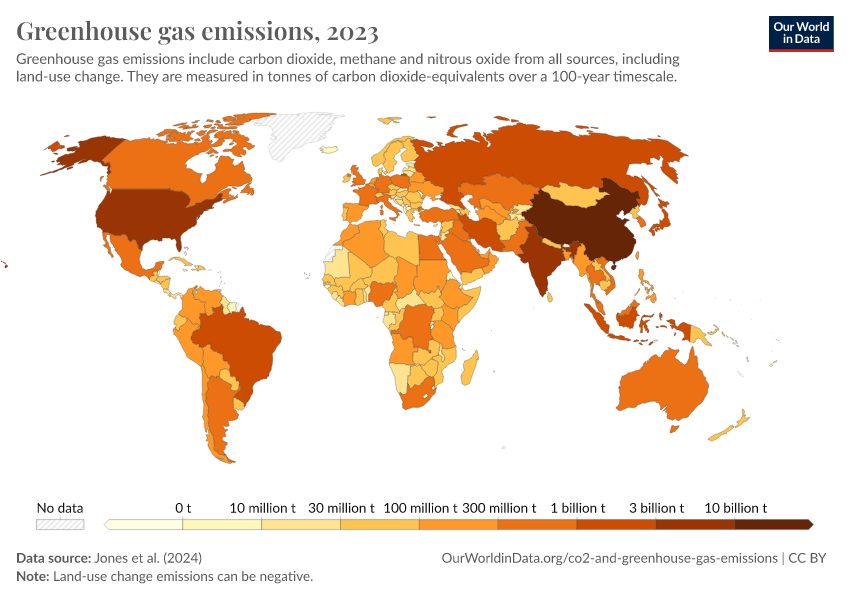
Per capita greenhouse gas emissions: how much does the average person emit?
Total annual emissions allow us to see the world's largest emitters in absolute terms. But they tend to tell a story of population — China and India, for example, are in the top three emitters, but are also the two most populous countries in the world.
How do emissions compare when we correct for the population?
This interactive map shows per capita greenhouse gas emissions. This is measured in tonnes per person per year.
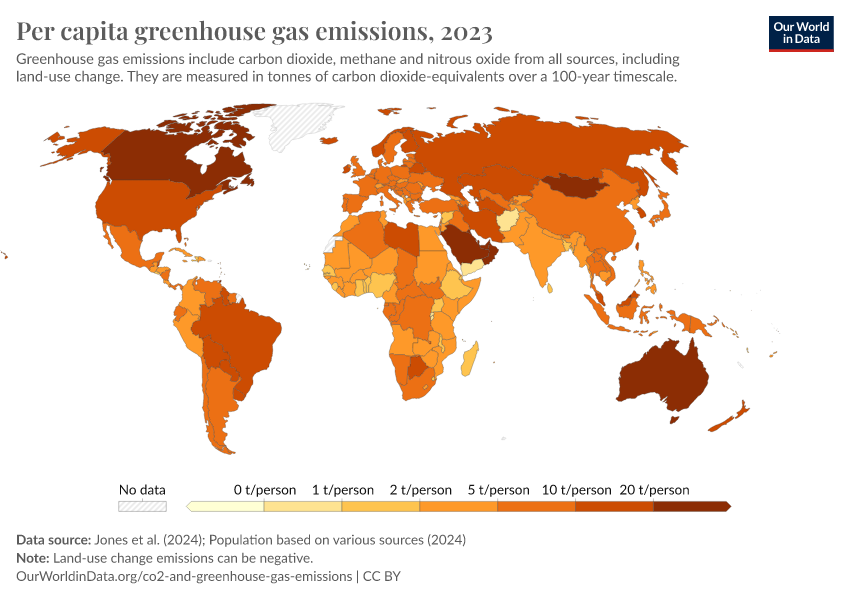
By gas: how much does each contribute to total greenhouse gas emissions?
Total greenhouse gas emissions are the sum of emissions of various gases: carbon dioxide, methane, nitrous oxide, and smaller trace gases such as hydrofluorocarbons (HFCs) and sulfur hexafluoride (SF6).
How much does each gas contribute to global greenhouse gas emissions?
In the chart, we see the breakdown of global emissions, measured based on carbon dioxide-equivalents (CO2e).

Methane (CH4) emissions
Where does methane come from?
Agriculture, fossil fuel production, and the management of waste are the primary sources of methane emissions:
- Livestock (ruminant animals — cattle, goats, and sheep) produce methane through a process called 'enteric fermentation'.
- Rice cultivation produces methane — waterlogged paddy fields provide an ideal environment for microbes to produce methane in a process called 'methanogenesis'.
- Biomass burning: methane is produced from the incomplete combustion of large-scale burning of woodlands, savanna, and agricultural waste.
- Waste: the decomposition of organic waste in landfills produces methane.
- Fossil fuel production: methane can be released during oil and gas extraction – a category often termed 'fugitive emissions'.
What is the warming potential of methane compared to CO2?
Methane is a much stronger greenhouse gas than CO2 in terms of its 'warming potential'. Over a 100-year timescale, and without considering climate feedback, one tonne of methane would generate 28 times the amount of warming as one tonne of CO2.1,2,3
This means that, despite contributing a small amount of greenhouse gas emissions in terms of mass, methane has been responsible for around one-quarter of radiative forcing since 1750.4
How long does methane stay in the atmosphere?
Methane is a very 'short-lived' greenhouse gas. This means that after it accumulates in the atmosphere, it is removed relatively quickly — on the timescale of decades in contrast to CO2 which can persist in the atmosphere for centuries or even thousands of years. The average 'lifetime' of methane in the atmosphere is around 12 years.3
This means that reductions in methane emissions quickly result in reductions in the methane concentrations in the atmosphere. This would reduce its warming effects. So, tackling methane emissions could be an effective and rapid way to mitigate some of the impacts of climate change — on the timeframe of decades.5
Annual methane emissions: how much do we emit each year?
This interactive chart shows methane (CH₄) emissions across the world.
Methane emissions are measured in tonnes of carbon dioxide equivalent (CO2e), so are weighted for their 100-year global warming potential value.
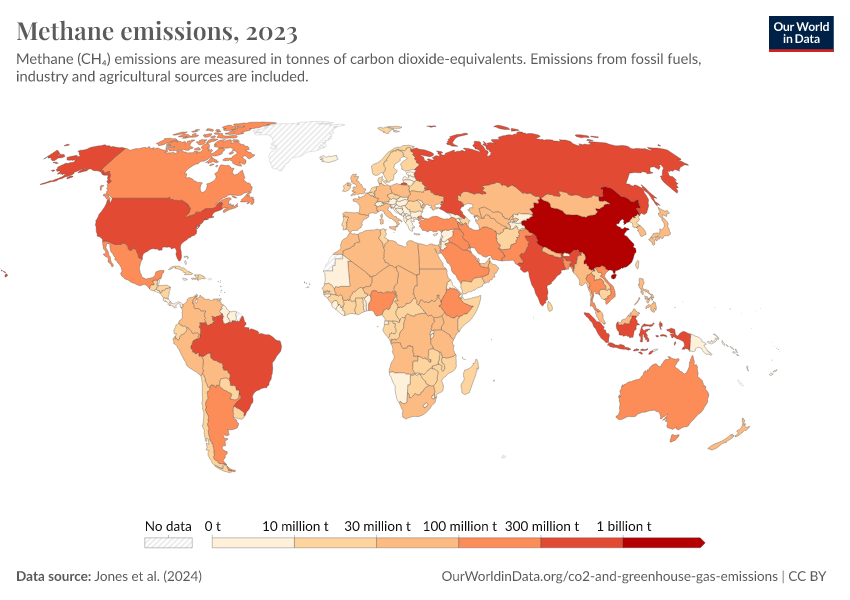
Per capita methane emissions: how much does the average person emit?
Total annual emissions allow us to see the world's largest emitters in absolute terms. But they can tell a story of population rather than lifestyle or individual impact.
How do emissions compare when we correct for the population?
This interactive map shows per capita methane emissions. This is measured in tonnes of carbon dioxide equivalents per person per year.
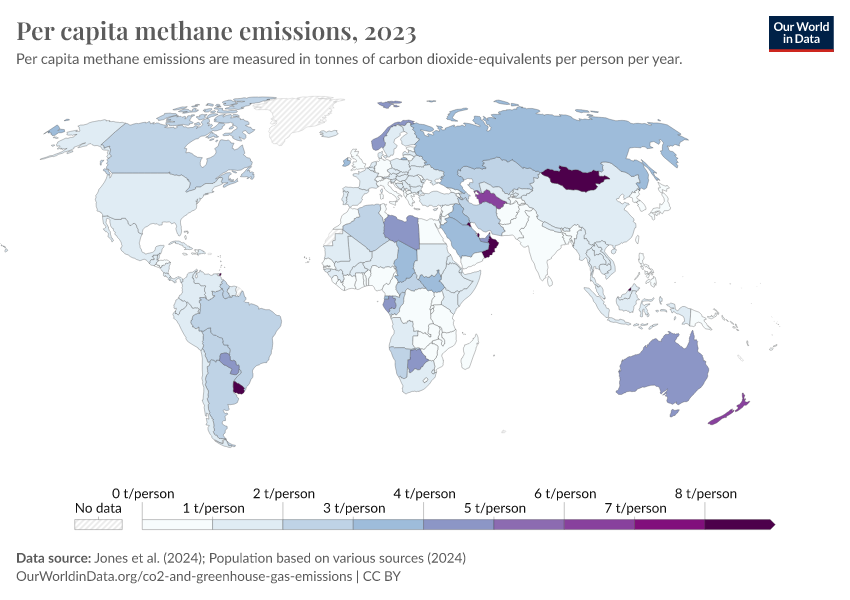
Nitrous oxide (N2O) emissions
Where does nitrous oxide come from?
Most of our nitrous oxide emissions come from agriculture: N2O is produced when we apply nitrogen fertilizers to soils.
Nitrous oxide is produced by microbes in nearly all soils. However, the application of nitrogen fertilizers makes much more nitrogen readily available for microbes to convert to N2O — this is because not all of the applied nutrients are taken up by crops.
Nitrous oxide is not only produced when synthetic nitrogen fertilizer is applied; the same processes occur when we use organic fertilizers such as animal manure.
What is the warming potential of nitrous oxide compared to CO2?
Nitrous oxide is a much stronger greenhouse gas than CO2 in terms of its 'warming potential'. Over a 100-year timescale, and without considering climate feedback, one tonne of nitrous oxide would generate 265 times the amount of warming as one tonne of CO2.6,3
How long does nitrous oxide stay in the atmosphere?
The average 'lifetime' of nitrous oxide in the atmosphere is around 121 years.3
This is typically shorter than CO2 (which can persist for centuries or even thousands of years), but longer than methane (which has an average lifetime of 12 years).
Annual nitrous oxide emissions: how much do we emit each year?
This interactive chart shows nitrous oxide (N2O) emissions across the world.
Nitrous oxide emissions are measured in tonnes of carbon dioxide equivalent (CO2e), so are weighted for their 100-year global warming potential value.
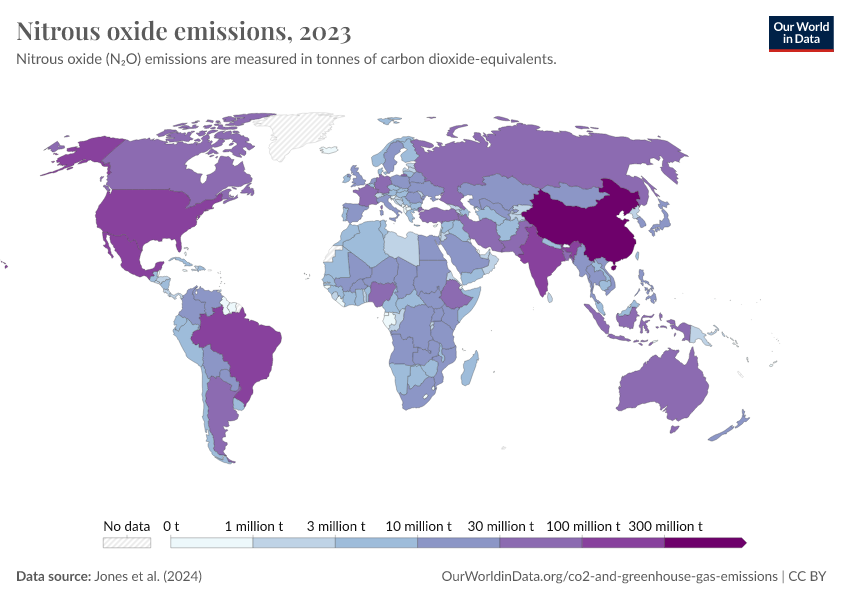
Per capita nitrous oxide emissions: how much does the average person emit?
How do emissions compare when we correct for the population?
This interactive map shows per capita nitrous oxide emissions. This is measured in tonnes of carbon dioxide equivalents per person per year.
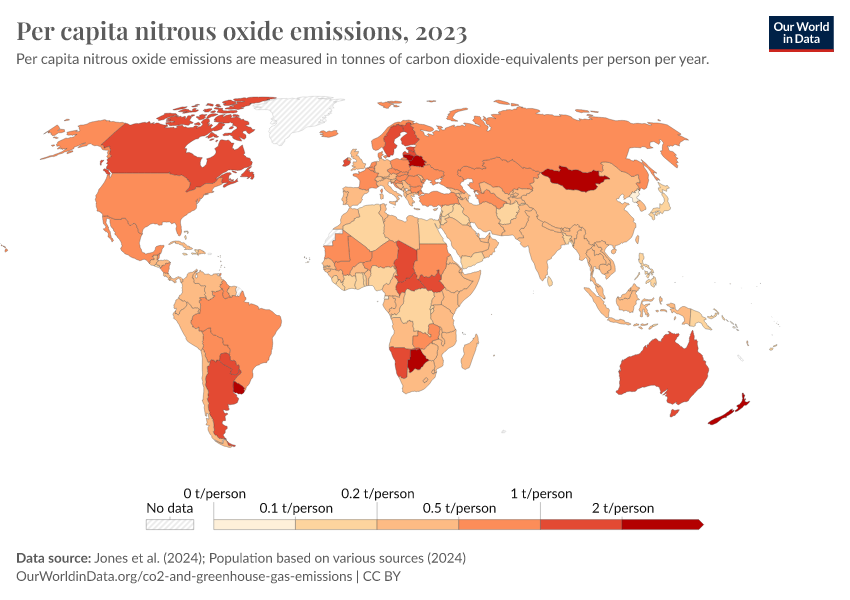
How do we quantify greenhouse gas emissions?
The standard metric used to quantify GHG emissions is ‘carbon dioxide-equivalents’. This is the metric adopted by the United Nations Framework Convention on Climate Change (UNFCCC); is used in official GHG reporting and target-setting by countries and institutions; and is the most widely adopted metric used within the scientific literature. As some researchers have highlighted, the lack of life-cycle assessment data disaggregated by gas can result in the loss of important information which could help us develop more optimal strategies for climate mitigation.7
What are carbon dioxide-equivalents? Carbon dioxide (CO2) is the most important greenhouse gas, but not the only one — gases such as methane and nitrous oxide are also drivers of global warming. Carbon dioxide-equivalents (CO2eq) try to sum all the warming impacts of the different greenhouse gases together to give a single measure of total greenhouse gas emissions. Two things make this more complicated: the gases have different ‘strengths’ of warming; and gases persist for different amounts of time in the atmosphere.
To convert non-CO2 gases into their carbon dioxide-equivalents we multiply their mass (e.g. kilograms of methane emitted) by their ‘global warming potential’ (GWP). GWP measures the warming impacts of a gas compared to CO2; it measures the ‘strength’ of the greenhouse gas averaged over a chosen time horizon. The standard way to do this is to evaluate the GWP over a 100-year timescale (GWP100). GWP100 is the accounting metric adopted by the Intergovernmental Panel on Climate Change (IPCC) in inventory guidelines, although their Fifth Assessment Report (AR5) did not explicitly recommend its use. Chapter 8 of this report described both GWP and Global Temperature-change Potential (GTP) as examples of different metrics that were useful depending on the question being asked.
The GWP100 value for methane from AR5 is 28 (or 34 if climate feedback processes are included).8 This means that emitting one kilogram of methane creates 28 times the amount of warming as one kilogram of CO2 averaged over the next 100 years. But what this doesn’t account for is the fact that methane is a short-lived greenhouse gas. It has a very strong warming impact when it is first emitted, but this warming impact diminishes over the following decades. Whereas, if you emitted the same amount of CO2, it could persist for centuries.
Using this GWP100 metric can therefore misrepresent the impact of short-lived gases such as methane in both directions.9 It underestimates short-term warming: the warming impact of methane when it’s first emitted and the following years is much higher than the ‘28’ value assigned by GWP100. Some people therefore argue that we should use a value that represents the global warming potential over 20 years (GWP20) since it gives a better indication of short-term warming. The IPCC reports a GWP20 value of 84 for methane (86 if feedbacks are included). Others argue that GWP100 overestimates the long-term impacts of methane; the methane emitted today will not be around a century from now. These differences are reflected by the large changes in GTP over different time horizons. The GTP100 value for methane is 4, whereas GTP20 is 67.
This makes it difficult to reconcile these warming impacts into a single metric. Our choice of metric can also impact how we prioritize GHG reduction strategies: do we first target strong but short-lived gases such as methane? This may slow warming in the short term — a reasonable argument if we are concerned about approaching temperature-induced tipping points. Or should we focus instead on the persistent CO2 emissions, which will be the primary driver of long-term temperature impacts?
Some researchers have developed new methods that aim to provide a closer representation of the actual temperature response to different gases. Myles Allen, Michelle Cain, and colleagues at the University of Oxford’s Martin School lead a research program on climate pollutants, which looks directly at this challenge.
They have proposed a new way to represent short-lived greenhouse gas emissions – GWP* — which aims to be more representative of the warming response.10,11 Dr Michelle Cain, one of the lead researchers in this area, discusses the challenges of GHG metrics and the role of a new GWP* metric, in an article in the Carbon Brief here.
GWP* is used to calculate CO2-warming-equivalent emissions, which reflects that (a) increasing methane emissions would immediately increase global temperature, (b) rapidly decreasing methane emissions would immediately reduce global temperature, and (c) a gradual decline in methane emissions would stabilize the global temperature attributed to methane. Scenarios (b) and (c) are very different from CO2, as rapidly or gradually decreasing CO2 emissions lead to further global temperature increases (only the rate of temperature increase slows).
This is explored further in an Oxford Martin School briefing note, found here, and the recent publication by researchers John Lynch, Michelle Cain, Raymond Pierrehumbert, and Myles Allen (2020).12
How do we account for the warming of different gases?
As discussed in previous sections, greenhouse gases vary in their relative contributions to global warming; i.e. one tonne of methane does not have the same impact on warming as one tonne of carbon dioxide.
We define these differences using the metric, 'Global Warming Potential' (GWP). GWP can be defined on a range of time periods, however, the most commonly used (and that adopted by the IPCC) is the 100-year timescale (GWP100).13
In the chart, we see the GWP100 value of key greenhouse gases relative to carbon dioxide. The GWP100 metric measures the relative warming impact of one molecule or unit mass of a greenhouse gas relative to carbon dioxide over a 100-year timescale. For example, one tonne of methane would have 28 times the warming impact of a tonne of carbon dioxide over a 100-year period. GWP100 values are used to combine greenhouse gases into a single metric of emissions called carbon dioxide equivalents (CO2e). CO2e is derived by multiplying the mass of emissions of a specific greenhouse gas by its equivalent GWP100 factor. The sum of all gases in their CO2e form provides a measure of total greenhouse gas emissions.
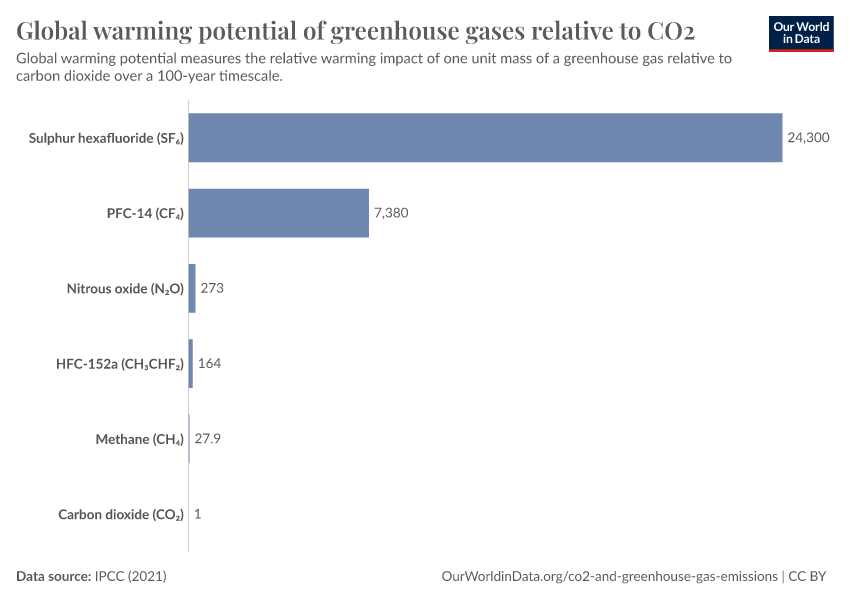
Endnotes
If climate feedback effects are included, this increases to 34 times that of CO2.
Saunois, M., Stavert, A. R., Poulter, B., Bousquet, P., Canadell, J. G., Jackson, R. B., ... & Ciais, P. (2020). The global methane budget 2000–2017. Earth System Science Data, 12(3), 1561-1623.
Myhre, G., D. Shindell, F.-M. Bréon, W. Collins, J. Fuglestvedt, J. Huang, D. Koch, J.-F. Lamarque, D. Lee, B. Mendoza, T. Nakajima, A. Robock, G. Stephens, T. Takemura and H. Zhang, 2013: Anthropogenic and Natural Radiative Forcing. In: Climate Change 2013: The Physical Science Basis. Contribution of Working Group I to the Fifth Assessment Report of the Intergovernmental Panel on Climate Change [Stocker, T.F., D. Qin, G.-K. Plattner, M. Tignor, S.K. Allen, J. Boschung, A. Nauels, Y. Xia, V. Bex and P.M. Midgley (eds.)]. Cambridge University Press, Cambridge, United Kingdom and New York, NY, USA.
Etminan, M., Myhre, G., Highwood, E. J., and Shine, K. P. (2016). Radiative forcing of carbon dioxide, methane, and nitrous oxide: A significant revision of the methane radiative forcing. Geophysical Research Letters, 43, 12614–12623.
Shindell, D., Kuylenstierna, J. C. I., Vignati, E., van Dingenen, R., Amann, M., Klimont, Z., Anenberg, S. C., Muller, N., Janssens-Maenhout, G., Raes, F., Schwartz, J., Faluvegi, G., Pozzoli, L., Kupiainen, K., Höglund-Isaksson, L., Emberson, L., Streets, D., Ramanathan, V., Hicks, K., Oanh, N. T. K., Milly, G., Williams, M., Demkine, V., and Fowler, D. (2012). Simultaneously Mitigating Near-Term Climate Change and Improving Human Health and Food Security, Science, 335, 183–189.
If climate feedback effects are included, this increases to 298 times that of CO2.
Lynch, J. (2019). Availability of disaggregated greenhouse gas emissions from beef cattle production: A systematic review. Environmental Impact Assessment Review, 76, 69-78.
IPCC, 2013: Climate Change 2013: The Physical Science Basis. Contribution of Working Group I to the Fifth Assessment Report of the Intergovernmental Panel on Climate Change [Stocker, T.F., D. Qin, G.-K. Plattner, M. Tignor, S.K. Allen, J. Boschung, A. Nauels, Y. Xia, V. Bex and P.M. Midgley (eds.)]. Cambridge University Press, Cambridge, United Kingdom and New York, NY, USA, 1535 pp.
Balcombe, P., Speirs, J. F., Brandon, N. P., & Hawkes, A. D. (2018). Methane emissions: choosing the right climate metric and time horizon. Environmental Science: Processes & Impacts, 20(10), 1323-1339.
Allen, M. R., Shine, K. P., Fuglestvedt, J. S., Millar, R. J., Cain, M., Frame, D. J., & Macey, A. H. (2018). A solution to the misrepresentations of CO 2-equivalent emissions of short-lived climate pollutants under ambitious mitigation. Npj Climate and Atmospheric Science, 1(1), 1-8.
Allen, M. R., Fuglestvedt, J. S., Shine, K. P., Reisinger, A., Pierrehumbert, R. T., & Forster, P. M. (2016). New use of global warming potentials to compare cumulative and short-lived climate pollutants. Nature Climate Change, 6(8), 773.
Lynch, J. M., Cain, M., Pierrehumbert, R. T., & Allen, M. (2020). Demonstrating GWP*: a means of reporting warming-equivalent emissions that captures the contrasting impacts of short-and long-lived climate pollutants. Environmental Research Letters.
IPCC, 2014: Climate Change 2014: Synthesis Report. Contribution of Working Groups I, II, and III to the Fifth Assessment Report of the
Intergovernmental Panel on Climate Change [Core Writing Team, R.K. Pachauri and L.A. Meyer (eds.)]. IPCC, Geneva, Switzerland, 151 pp. Available online.
Cite this work
Our articles and data visualizations rely on work from many different people and organizations. When citing this article, please also cite the underlying data sources. This article can be cited as:
Hannah Ritchie, Pablo Rosado, and Max Roser (2020) - “Greenhouse gas emissions” Published online at OurWorldinData.org. Retrieved from: 'https://archive.ourworldindata.org/20251204-133820/greenhouse-gas-emissions.html' [Online Resource] (archived on December 4, 2025).BibTeX citation
@article{owid-greenhouse-gas-emissions,
author = {Hannah Ritchie and Pablo Rosado and Max Roser},
title = {Greenhouse gas emissions},
journal = {Our World in Data},
year = {2020},
note = {https://archive.ourworldindata.org/20251204-133820/greenhouse-gas-emissions.html}
}Reuse this work freely
All visualizations, data, and code produced by Our World in Data are completely open access under the Creative Commons BY license. You have the permission to use, distribute, and reproduce these in any medium, provided the source and authors are credited.
The data produced by third parties and made available by Our World in Data is subject to the license terms from the original third-party authors. We will always indicate the original source of the data in our documentation, so you should always check the license of any such third-party data before use and redistribution.
All of our charts can be embedded in any site.